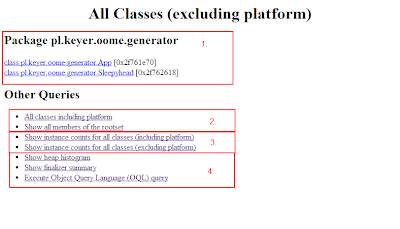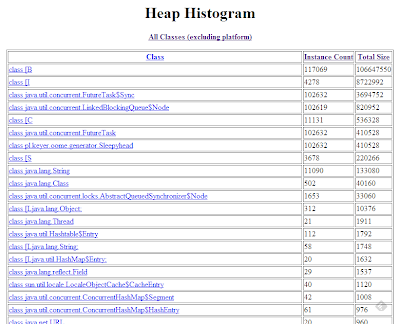Short jhat tutorial: diagnosing OutOfMemoryError by example
转自: http://petermodzelewski.blogspot.com/2013/06/short-jhat-tutorial-diagnosing.html
jhat这个工具经过使用, 发现非常不好用, 分析稍微比较大一点的dumo文件就会非常慢, 而且占用内存太大, 所以建议用mat.这个教材写的还是不错的, 所以先转载一下
Last time we've learned what can be the reason of OutOfMemoryErrors and what tool-chain can we use to diagnose it. Today we will learn by example how to use the most important one: jhat.
I've prepared a sample project for this exercise, which can be cloned from github. The code is really simple and its problem is obvious, but this simplicity will make it easy to get to know jhat.
First, we need to run our program. We will use small heap size, for two reasons:
- Program will throw the exception faster
- jhat will start more quickly, as the heap dump will be smaller
|
1
2
3
4
5
6
7
|
$ git clone https://github.com/petermodzelewski/snippets.git$ cd snippets/OutOfMemoryErrorGenerator/$ mvn package$ java -Xmx128m -Xms128m -jar target/OutOfMemoryErrorGenerator-1.0.jarException in thread "main" java.lang.OutOfMemoryError: Java heap space at pl.keyer.oome.generator.Sleepyhead(Sleepyhead.java:6) at pl.keyer.oome.generator.App.main(App.java:11) |
We can notice, that the program is still running. We will need another console to run jhat. We are using the following commands:
|
1
2
3
4
5
6
7
8
9
10
11
12
13
14
|
$ jps -l752 target/OutOfMemoryErrorGenerator-1.0.jar4480 sun.tools.jps.Jps$ jmap -dump:file=dump.map 752$ jhat -port 7401 dump.mapReading from dump.map...Dump file created Sat Jun 01 23:25:55 CEST 2013Snapshot read, resolving...Resolving 561438 objects...Chasing references, expect 112 dots................................................................................................................Eliminating duplicate references................................................................................................................Snapshot resolved.Started HTTP server on port 7401Server is ready. |
Important notes about that process:
- All commands must be executed by the same user: the java process owner
- The "expect X dots" message is not a joke. While processing bigger heap dumps one can check the number of dots there in editor to see the progress, as it can take quite a while to process such a file.
- When processing bigger dumps one must watch heap size of jhat itself. This depends on the case, but to be safe (provided with enough resources) jhat should have 2-4 times more heap size, than process heap it will diagnose. If memory size for jhat is too small it will just crush after using it and the process will need to be repeated with bigger amount of memory. For example to provide jhat with 4 gigs the command will be:
1
$ jhat -port7401-J-mx4G dump.map - Diagnosed process may be terminated after dumping heap with jmap.
- Obviously jhat can be run on any machine where the dump will be present. On many occasions developers choose to zip the dump and move the debug process to machine more accessible for them and with enough ram.
After executing the commands we can visit http://localhost:7401/

When facing with jhat You will quickly realize that this tool is from times, where such tools were designed without consideration of prettiness or usability. This tutorial will show how to navigate it in most cases - all it's features are cool and necessary, but everyday programmer will use only subset of them to quickly diagnose where the OOME came from.
jhat main page can be divided into sections:
- List of all classes in your program (excluding platform - that is, all that is not from standard library). This list is normally really long and in most cases it is not necessary. Normally You will scroll down to "Other Queries" section right away.
- More options for listing classes
- Bread and butter of memory debugging, we will use them in a moment
- More tools for debugging, but not as helpfull as section 3.
- Heap histogram is sometimes useful to compare quantity vs size of objects
- When you become jhat ninja, you sometimes could use OQLto diagnose the application. It is a SQL-like language for searching heap and calculating it's statistics.




http://localhost:7401/class/0x3881d790
so the reference by type summery will have url as follow:
http://localhost:7401/refsByType/0x3881d790

Short jhat tutorial: diagnosing OutOfMemoryError by example的更多相关文章
- Java中的OutOfMemoryError的各种情况及解决和JVM内存结构
在JVM中内存一共有3种:Heap(堆内存),Non-Heap(非堆内存) [3]和Native(本地内存). [1] 堆内存是运行时分配所有类实例和数组的一块内存区域.非堆内存包含方法区和JVM内部 ...
- PBS命令和使用
PBS是公开源代码的作业管理系统,在此环境下运行,用户不需要指定程序在哪些节点上运行,程序所需的硬件资源由PBS管理和分配. PBS(Portable Batch System)是由NASA开发的灵活 ...
- Kristen Grauman
http://www.cs.utexas.edu/~grauman/ CV Publications Code Data Short ...
- 游戏引擎架构 (Jason Gregory 著)
第一部分 基础 第1章 导论 (已看) 第2章 专业工具 (已看) 第3章 游戏软件工程基础 (已看) 第4章 游戏所需的三维数学 (已看) 第二部分 低阶引擎系统 第5章 游戏支持系统 (已看) 第 ...
- Unity性能优化(2)-官方教程Diagnosing performance problems using the Profiler window翻译
本文是Unity官方教程,性能优化系列的第二篇<Diagnosing performance problems using the Profiler window>的简单翻译. 相关文章: ...
- JVM性能调优监控工具jps、jstack、jmap、jhat、jstat、hprof使用详解
摘要: JDK本身提供了很多方便的JVM性能调优监控工具,除了集成式的VisualVM和jConsole外,还有jps.jstack.jmap.jhat.jstat.hprof等小巧的工具,本博客希望 ...
- JVM性能调优监控工具jps、jstack、jmap、jhat、jstat使用详解(转VIII)
JVM本身就是一个java进程,一个java程序运行在一个jvm进程中.多个java程序同时运行就会有多个jvm进程.一个jvm进程有多个线程至少有一个gc线程和一个用户线程. JDK本身提供了很多方 ...
- 遭遇OutOfMemoryError
这几天,网店系统基础架构进行了一次大的升级,升级之后例行的进行了压力测试,以前几次大的项目发布压力测试都没有任何问题,没想到这次出事故啦,而且是内存泄露? 系统运行环境:硬件:Intel(R) Xeo ...
- UE4 Tutorial - Custom Mesh Component 用于绘制自定义网格的插件CustomMeshComponent
UE4 中用于绘制自定义网格的插件CustomMeshComponent. 转载: UE4 Tutorial - Custom Mesh Component Over the last few w ...
随机推荐
- Futures
Futures is a framework for expressing asynchronous code in C++ using the Promise/Future pattern. Ove ...
- 第二章:Android Studio概述(二)[学习Android Studio汉化教程]
The Main Menu Bar 主菜单栏 主菜单栏位于Android Studio的最上面,你几乎可以利用主菜单和其子菜单来执行任何操作.不像Android Studio中其他的一些菜单,主菜单 ...
- eclipse项目推送git
引用:http://blog.csdn.net/zongzhankui/article/details/48653731
- 记一则css3计算
.Head{ background-image: url("../../Img/PersonalCenter/banner.png"); background-repeat: no ...
- 「小程序JAVA实战」swagger2的使用与接口测试(34)
转自:https://idig8.com/2018/08/31/xiaochengxujavashizhanswagger2deshiyongyujiekouceshi34/ 我们已经开发完了一个用户 ...
- django -- 内置分页
urls.py from django.conf.urls import url from conn_oracle import views urlpatterns = [ url(r'^page/' ...
- 找不到 org/springframework/dao/support/PersistenceExceptionTranslator
如果用的spring2 则原因是缺少spring-dao.jar 如果用的是spring3(我就栽这儿了) 则原因是缺少org.springframework.transaction-3.0.4.R ...
- 插入后获取到id
第一种方法: insert INTO student(name) VALUES("南亚");SELECT @@identity 第二种方法: insert INTO student ...
- 奶牛易物-Alpha版本测试报告
1.在测试过程中总共发现了多少Bug?每个类别的Bug分别为多少个? a. 修复的bug: 1.mapper接口与mapper.xml文件绑定的问题; 2..配置逆向工程的配置文件的问题; 3.在编码 ...
- java算法 第七届 蓝桥杯B组(题+答案) 5.抽签
5.抽签 (代码填空) X星球要派出一个5人组成的观察团前往W星.其中:A国最多可以派出4人.B国最多可以派出2人.C国最多可以派出2人..... 那么最终派往W星的观察团会有多少种国别的不同组合呢 ...
